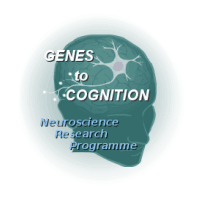An Integrative Neuroscience Program Linking Mouse Genes to Cognition and Disease
Seth G. N. Grant
(Taken from Behavioural Genetics in the Post Genomic Era, Edited by Robert Plomin, John C Defries, Ian W Craig and Peter McGuffin, American Psychological Association 2002. ISBN 1-55798-926-5) PDF version
- Introduction
- General Strategy & Outline
- Connecting the Molecular Mechanisms of Learning
- A Multilayer Organisation
- Layer 1: Identification of Genes Encoding Assemblies
- Layer 2: Genomics
- Layer 3: Functional Genomics - Experimental Neuroscience
- Layer 4: Informatics
- Structural Issues for a Large Multidisciplinary Program
- Conclusions
Structural Issues for a Large Multidisciplinary Program
The G2C approach is well-suited to be organized as a national or international consortium. The structure can be broken down into component areas, such as the four layers, where these areas are managed by experts. A relatively fixed framework with considerable flexibility would be desirable during the phase of construction. The initial phase of construction could proceed around the existing framework that has developed from the study of learning. This framework, which could be described as the vertical component because it links genes, proteins, cells, circuits, and behaviour, presents the major challenges in terms of constructing the new databases, the general management, and coordination. Once this was established, the G2C could be expanded using several strategies. First, using the entry point at Layer 1, new systems or assemblies could be identified and processed. For example, there are areas of developmental neuroscience in which sets of genes and pathways have been identified. Here, experts in these areas could meet and discuss Layer 1, whereupon Layer 2 could be performed by other genotyping experts. In the broadest sense, the consortium could be seen as a platform for scientists in specialized areas to join a program that connects their work with those at other points in the vertical organization.
A second driving force is the collection of human DNA samples. In the area of clinical neuroscience (psychiatry, neurology, and neurosurgery), there has been substantial effort placed on the collection of DNAs from individuals and families with heritable conditions. It is outside the scope of this chapter to review this in detail; however, it is worth noting that there is a considerable need for further collection, including for conditions that have not gained as much attention as some of the major disorders. The availability of these DNAs for Layer 2 of the G2C would influence the choice of gene sets from Layer 1.
A third way to expand the G2C is around the cell biology of neurons and glia. For example, my colleagues and I have initiated the G2C by focusing on a particular synaptic multiprotein complex. The next step could be to include other synaptic protein complexes and move toward genotyping for all synaptic proteins. The number of synaptic proteins is probably around 2,000, and many of these are now known. These could also be used to constitute a set for Layer 1. Thus, one could expand this approach to include dendritic, axonal and other sets of neuronal proteins. Similarly, this type of categorization could be applied to glial cells. The use of microarray technology for monitoring messenger RNA expression, will assist in generating these data, especially as arrays encoding all known transcripts are available. In the broadest sense, it would be possible to extend the G2C to examine all genes expressed in the brain.
